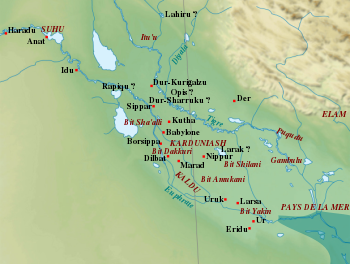Bit-Amukkani

Bit-Amukani (in the Aramaic Assur Ostracon ʾwkn; Assyrian mA-muk-ka-nu; Babylonian diBit U-ka-a-ni, diU-ka-nu; lit. House of Amukani) was a tribe, proto-state founded by Chaldeans in southern Mesopotamia which stretched from southeast of Nippur to the area of Uruk.[1] It is considered[by whom?] as one of the most powerful Chaldean tribes, next to Bīt-Iakin and Bīt-Dakkūri.
As early as 732. B.C.E. it was ruled by prince
Tiglath-pileser III devastated Bit-Amukani for the second time and defeated Mukin-zeri.[2] Shalmaneser III (856-824) inscriptions note that two Chaldean leaders (Mušallim-Marduk of Bīt-Amukāni and Adīnu of Bīt-Dakkūri) carried silver, gold, tin, bronze, elephant tusks, elephant skins, ebony and sissoowood (or meskannu-wood) as a tribute to the King of Assyria
.
Though unconfirmed statement, the economy of Bīt-Amūkāni probably relied on producing dates.
Tiglath-pileser III's writings testify about conflict with Bīt-Amūkāni, Bīt-Amūkāni never went extinct but actually remained important through later Babylonian
history.
Sennacherib's inscriptions note that Bit-Amukani consisted of 39 walled cities and 350 villages.[3] Its capital was Sapia (Assyrian Sapīya or Šapīya).
List of Bīt-Amūkāni leaders
| Name[4] | Reign | Comments | |
|---|---|---|---|
| Mušallim-Marduk | somewhere during Shalmaneser III | gave tribute to Shalmaneser III in 850 | |
| (Nabû-)mukīn-zēri, king | 731–729 | deposed by Tiglath-pileser III; besieged in Šapīya, but not captured father of Šuma-ukīn | |
| Ea-zēra-(i)qīša | 673 > time of Ashurbanipal | held hostage in Assyria during rebellion of 652–648; his mother was Humbušte (or Humbuštu); assured loyalty of Bit Amukani to Ashurbanipal | |
| ? Kudurru | ca. rebellion of 652–648? | position in tribe uncertain, according to Lipinski governor of Uruk;[5] probably was not Bit-Amukanean, but rather installed by Ashurbanipal |
References
- ^ Zadok, Ran (1985). On West Semites in Babylonia during the Chaldean and Achaemenian Periods: An Onomastic Study. pp. 58–62.
- ^ OCLC 774282690.
- ISBN 978-1-58983-128-5.)
{{cite book}}: CS1 maint: location missing publisher (link - ^ Frame, Grant. "The Political History and Historical Geography of the Aramean, Chaldean, and Arab Tribes in Babylonia in the Neo-Assyrian Period".
{{cite journal}}: Cite journal requires|journal=(help) - ISBN 978-90-429-0859-8.
